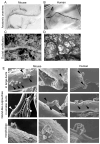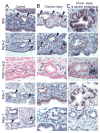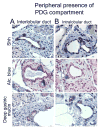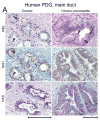Pancreatic duct glands are distinct ductal compartments that react to chronic injury and mediate Shh-induced metaplasia
- PMID: 20026066
- PMCID: PMC3806111
- DOI: 10.1053/j.gastro.2009.12.005
Pancreatic duct glands are distinct ductal compartments that react to chronic injury and mediate Shh-induced metaplasia
Abstract
Background & aims: Pancreatic intraepithelial neoplasia (PanIN) are pancreatic cancer precursor lesions of unclear origin and significance. PanIN aberrantly express sonic hedgehog (Shh), an initiator of pancreatic cancer, and gastrointestinal mucins. A majority of PanIN are thought to arise from ducts. We identified a novel ductal compartment that is gathered in gland-like outpouches (pancreatic duct glands [PDG]) of major ducts and characterized its role in injury and metaplasia.
Methods: The ductal system was analyzed in normal pancreata and chronic pancreatitis in humans and mice. Anatomy was assessed by serial hematoxylin and eosin sections and scanning electron microscopy of corrosion casts. Expression of mucins and developmental genes and proliferation were assessed by immunohistochemistry or real-time quantitative polymerase chain reaction. Effects of Shh on ductal cells were investigated by exposure to Shh in vitro and transgenic misexpression in vivo.
Results: Three-dimensional analysis revealed blind-ending outpouches of ducts in murine and human pancreata. These PDG are morphologically and molecularly distinct from normal ducts; even in normal pancreata they display PanIN and metaplastic features, such as expression of Shh and gastric mucins. They express other developmental genes, such as Pdx-1 and Hes-1. In injury, Shh is up-regulated along with gastric mucins. Expansion of the PDG compartment results in a mucinous metaplasia. Shh promotes this transformation in vitro and in vivo.
Conclusions: PDG are distinct gland-like mucinous compartments with a distinct molecular signature. In response to injury, PDG undergo an Shh-mediated mucinous gastrointestinal metaplasia with PanIN-like features. PDG may provide a link between Shh, mucinous metaplasia, and neoplasia.
Copyright 2010 AGA Institute. Published by Elsevier Inc. All rights reserved.
Conflict of interest statement
None of the authors have a conflict of interest.
Figures













Comment in
-
Tracking down the hedgehog's lair in the pancreas.Gastroenterology. 2010 Mar;138(3):823-5. doi: 10.1053/j.gastro.2010.01.021. Epub 2010 Jan 25. Gastroenterology. 2010. PMID: 20100446 Free PMC article. No abstract available.
Similar articles
-
Tracking down the hedgehog's lair in the pancreas.Gastroenterology. 2010 Mar;138(3):823-5. doi: 10.1053/j.gastro.2010.01.021. Epub 2010 Jan 25. Gastroenterology. 2010. PMID: 20100446 Free PMC article. No abstract available.
-
Loss of Trefoil Factor 2 From Pancreatic Duct Glands Promotes Formation of Intraductal Papillary Mucinous Neoplasms in Mice.Gastroenterology. 2016 Dec;151(6):1232-1244.e10. doi: 10.1053/j.gastro.2016.07.045. Epub 2016 Aug 12. Gastroenterology. 2016. PMID: 27523981 Free PMC article.
-
Gene expression profiles in pancreatic intraepithelial neoplasia reflect the effects of Hedgehog signaling on pancreatic ductal epithelial cells.Cancer Res. 2005 Mar 1;65(5):1619-26. doi: 10.1158/0008-5472.CAN-04-1413. Cancer Res. 2005. PMID: 15753353
-
Morphogenesis of pancreatic cancer: role of pancreatic intraepithelial neoplasia (PanINs).Langenbecks Arch Surg. 2008 Jul;393(4):561-70. doi: 10.1007/s00423-008-0282-x. Epub 2008 Feb 19. Langenbecks Arch Surg. 2008. PMID: 18283486 Free PMC article. Review.
-
Acinar-to-Ductal Metaplasia (ADM): On the Road to Pancreatic Intraepithelial Neoplasia (PanIN) and Pancreatic Cancer.Int J Mol Sci. 2023 Jun 9;24(12):9946. doi: 10.3390/ijms24129946. Int J Mol Sci. 2023. PMID: 37373094 Free PMC article. Review.
Cited by
-
The impact of hypoxia in pancreatic cancer invasion and metastasis.Hypoxia (Auckl). 2014 Jul 16;2:91-106. doi: 10.2147/HP.S52636. eCollection 2014. Hypoxia (Auckl). 2014. PMID: 27774469 Free PMC article. Review.
-
Tracking down the hedgehog's lair in the pancreas.Gastroenterology. 2010 Mar;138(3):823-5. doi: 10.1053/j.gastro.2010.01.021. Epub 2010 Jan 25. Gastroenterology. 2010. PMID: 20100446 Free PMC article. No abstract available.
-
Residual embryonic cells as precursors of a Barrett's-like metaplasia.Cell. 2011 Jun 24;145(7):1023-35. doi: 10.1016/j.cell.2011.05.026. Cell. 2011. PMID: 21703447 Free PMC article.
-
Increased Proliferation of the Pancreatic Duct Gland Compartment in Type 1 Diabetes.J Clin Endocrinol Metab. 2017 Jan 1;102(1):200-209. doi: 10.1210/jc.2016-3001. J Clin Endocrinol Metab. 2017. PMID: 27813705 Free PMC article.
-
Vertically integrated translational studies of PDX1 as a therapeutic target for pancreatic cancer via a novel bifunctional RNAi platform.Cancer Gene Ther. 2014 Feb;21(2):48-53. doi: 10.1038/cgt.2013.84. Epub 2014 Jan 24. Cancer Gene Ther. 2014. PMID: 24457987 Review.
References
-
- Hruban RH, Adsay NV, Albores-Saavedra J, et al. Pancreatic intraepithelial neoplasia: a new nomenclature and classification system for pancreatic duct lesions. Am J Surg Pathol. 2001;25:579–586. - PubMed
-
- Guerra C, Schuhmacher AJ, Canamero M, et al. Chronic pancreatitis is essential for induction of pancreatic ductal adenocarcinoma by K-Ras oncogenes in adult mice. Cancer Cell. 2007;11:291–302. - PubMed
Publication types
MeSH terms
Substances
Grants and funding
LinkOut - more resources
Full Text Sources
Medical

